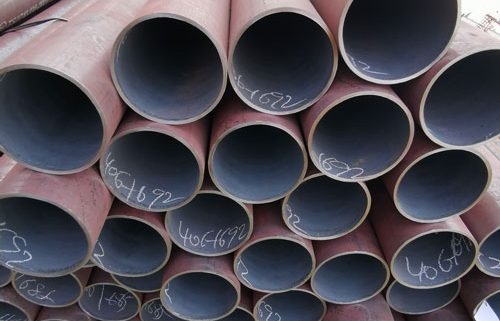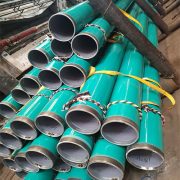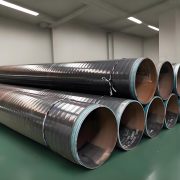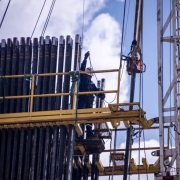The Definition of Line Pipe
In industries where fluids like oil, gas, and water need to be transported over long distances, the choice of piping systems is critical to ensure safety, efficiency, and cost-effectiveness. One of the most commonly used components in these sectors is line pipe. This blog post provides a detailed look into what line pipe is, its key features, applications, and considerations for professionals working in the transmission of oil, gas, and water.
What is Line Pipe?
Line pipe is a type of steel pipe that is specifically designed for the transportation of liquids, gases, and sometimes solids. Typically manufactured from carbon or alloy steel, line pipe is engineered to withstand high pressure, corrosion, and extreme temperatures, making it ideal for industries such as oil and gas, where fluids need to be transported over vast distances.
Line pipe plays a pivotal role in pipelines that move oil, natural gas, water, and other fluids from production facilities to refineries, processing plants, or distribution networks. It serves as the backbone of energy infrastructure, ensuring that raw materials are efficiently and safely delivered.
Key Features of Line Pipe
Line pipes are manufactured to meet strict standards and are available in various grades, dimensions, and materials to suit the needs of specific transmission systems. Here are some critical features that make line pipe an essential component for fluid transport:
1. Material Strength and Durability
Line pipe is primarily made from carbon steel, but other alloys such as stainless steel and high-strength, low-alloy steel may be used depending on the application. These materials offer excellent tensile strength, allowing the pipe to withstand high internal pressures and the mechanical stresses of installation and operation.
2. Corrosion Resistance
Corrosion is a significant concern in pipelines, especially those transporting oil, gas, or water over long distances. Line pipes often undergo various coating and treatment processes, such as galvanization, epoxy coatings, or cathodic protection systems, to resist corrosion and extend their operational lifespan.
3. High Pressure and Temperature Tolerance
Line pipes are designed to operate under high-pressure conditions. Depending on the fluid being transported and the environmental conditions, the pipe must tolerate significant fluctuations in temperature. Pipeline grades, such as API 5L, specify performance standards for different pressures and temperatures.
4. Weldability
Since pipelines are typically constructed in sections and welded together, line pipe must possess good weldability characteristics. Weldability ensures a secure, leak-proof connection between sections of pipe, contributing to the overall integrity of the pipeline.
Types of Line Pipe
Line pipes come in several types, each suited to specific needs. Here are the two primary types used in oil, gas, and water transmission:
1. Seamless Line Pipe
Seamless line pipe is manufactured without a seam, making it ideal for high-pressure applications. It is produced by rolling solid steel into a tube form and then extruding it to the desired thickness and diameter. Seamless line pipe offers higher strength and better resistance to corrosion and stress cracking.
2. Welded Line Pipe
Welded line pipe is made by forming flat steel into a cylindrical shape and welding the edges together. Welded pipe can be produced in large diameters, making it more cost-effective for low- to medium-pressure applications. However, welded pipe is more susceptible to stress at the seam, so it is often used where operating pressures are lower.
Common Applications of Line Pipe
Line pipe is used in a wide range of industries, including:
1. Oil Transmission
In the oil industry, line pipe is used to transport crude oil from extraction sites to refineries. The pipe must withstand high pressure, corrosive materials, and abrasive conditions, ensuring safe and continuous transportation over long distances.
2. Natural Gas Transmission
Natural gas pipelines require line pipe that can handle high pressures and remain leak-proof under fluctuating environmental conditions. Line pipes in natural gas applications also undergo additional testing for toughness and resistance to brittle fracture, especially in colder climates.
3. Water Distribution
Line pipes are extensively used for the distribution of potable water, wastewater, and industrial water. In water transmission, corrosion resistance is a major concern, and coatings or linings, such as cement mortar or polyethylene, are often applied to protect the steel and extend the pipe’s lifespan.
4. Chemical Transmission
Pipelines in the chemical industry transport a variety of liquids and gases, some of which may be corrosive or hazardous. Line pipe used in these applications must meet stringent safety standards to ensure there are no leaks or failures that could lead to environmental damage or safety hazards.
Key Standards for Line Pipe
Line pipes used in the oil, gas, and water transmission industries are subject to various international standards, which ensure that the pipes meet the necessary safety, performance, and quality requirements. Some of the most widely recognized standards include:
- API 5L (American Petroleum Institute): This is the most commonly referenced standard for line pipes used in oil and gas transmission. API 5L defines requirements for pipe material, mechanical properties, and testing methods.
- ISO 3183 (International Organization for Standardization): This standard covers the specifications for steel line pipes for pipeline transportation systems in the petroleum and natural gas industries. ISO 3183 ensures that line pipes are manufactured according to global best practices.
- ASME B31.8 (American Society of Mechanical Engineers): This standard focuses on gas transmission and distribution piping systems. It provides guidelines on the design, materials, construction, testing, and operation of pipelines.
- EN 10208-2 (European Standard): This standard applies to steel pipes used in the transmission of flammable liquids or gases in European countries. It sets performance benchmarks for materials, dimensions, and testing.
Common Standard and Steel Grade
| PSL1 Line Pipe Mechanical properties | |||
| Grade | Yield strength Rt0,5 Mpa(psi) | Tensile strength Rm Mpa(psi) | Elongation 50mm or 2in |
| A25/A25P | ≥175(25400) | ≥310(45000) | Af |
| A | ≥210(30500) | ≥335(48600) | Af |
| B | ≥245(35500) | ≥415(60200) | Af |
| X42 | ≥290(42100) | ≥415(60200) | Af |
| X46 | ≥320(46400) | ≥435(63100) | Af |
| X52 | ≥360(52200) | ≥460(66700) | Af |
| X56 | ≥390(56600) | ≥490(71100) | Af |
| X60 | ≥415(60200) | ≥520(75400) | Af |
| X65 | ≥450(65300) | ≥535(77600) | Af |
| X70 | ≥485(70300) | ≥570(82700) | Af |
| PSL2 Line Pipe Mechanical properties | ||||
| Grade | Yield strength Rt0,5 Mpa(psi) | Tensile strength Rm Mpa(psi) | Rt0,5/Rm | Elongation 50mm or 2in |
| BR/BN/BQ | 245(35500)-450(65300) | 415(60200)-655(95000) | ≤0.93 | Af |
| X42R/X42N/X42Q | 290(42100)-495(71800) | ≥415(60200) | ≤0.93 | Af |
| X46N/X46Q | 320(46400)-525(76100) | 435(63100)-655(95000) | ≤0.93 | Af |
| X52N/X52Q | 360(52200)-530(76900) | 460(66700)-760(110200) | ≤0.93 | Af |
| X56N/X56Q | 390(56600)-545(79000) | 490(71100)-760(110200) | ≤0.93 | Af |
| X60N/X60Q | 415(60200)-565(81900) | 520(75400)-760(110200) | ≤0.93 | Af |
| X65Q | 450(65300)-600(87000) | 535(77600)-760(110200) | ≤0.93 | Af |
| X70Q | 485(70300)-635(92100) | 570(82700)-760(110200) | ≤0.93 | Af |
Practical Considerations for Line Pipe Selection
When selecting line pipe for oil, gas, or water transmission, it is essential to consider several factors to ensure optimal performance and safety. Here are some key considerations:
1. Operating Pressure and Temperature
The pipe material and wall thickness must be chosen to handle the expected operating pressure and temperature of the fluid. Over-pressurization can lead to pipeline failure, while insufficient tolerance for high temperatures may result in weakening or deformation.
2. Corrosiveness of the Fluid
Corrosive fluids such as crude oil or certain chemicals may require specialized coatings or materials. Selecting a pipe with the appropriate corrosion resistance can significantly extend the pipeline’s service life.
3. Distance and Terrain
The length and location of the pipeline will impact the type of line pipe needed. For example, pipelines crossing mountainous regions or areas with extreme temperatures may need more durable, thicker pipes to handle the stress and environmental conditions.
4. Regulatory and Safety Compliance
Compliance with local, national, and international regulations is critical. Ensure that the line pipe meets the required standards for the region and industry in which it will be used. This is especially important in hazardous industries like oil and gas, where pipeline failures can have severe environmental and safety consequences.
Conclusion
Line pipe is a critical component in the oil, gas, and water transmission industries. Its strength, durability, and ability to withstand extreme conditions make it indispensable for transporting fluids over long distances. By understanding the different types of line pipe, their applications, and key considerations for selection, professionals in these fields can ensure the safe and efficient operation of pipelines.
Whether you are working in oil extraction, natural gas distribution, or water infrastructure, selecting the right line pipe is essential for maintaining the integrity of your transmission systems. Always prioritize quality, safety, and compliance with industry standards to optimize pipeline performance and prevent costly failures.








